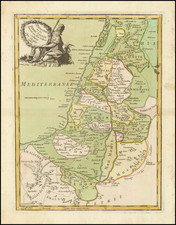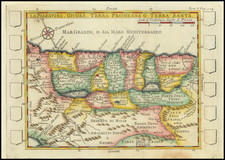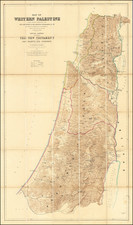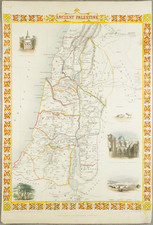Sailing the Red Sea in the Eighteenth Century
Fine, detailed chart of the southern part of the Red Sea from the expanded second edition of Mannevillette’s influential Neptune Oriental.
It was based on a chart sent to Mannevillette by the imperial official Jean Law de Lauriston.
The chart is east-oriented, with the Arabian Peninsula at the top and the coast of Abyssinia, another name for the Ethiopian Empire, at the bottom. It runs from Jeddah (Gedda), in present-day Saudi Arabia, south to Mocha (Moku), in present-day Yemen. The African coast shown here today is part of Sudan and Eritrea.
The chart includes three insets, Shake Omare and Goofs, both near Jeddah, and Gedan. The only inland details are profiles of high ground that could be spotted from the deck of a ship. The Red Sea, however, is covered in information including rhumb lines, sounding depths, the outlines of sandbars and other navigational obstructions, and descriptions of the bottom quality in various places.
Under the title is a block of text in French. It translates as:
This map was sent to the author by Mr. Law de Laurison, Commandant of the French Establishments in India: it is looked upon there by the English navigators who most frequently travel from Mocha to Jeddah, as one of the best maps of this part; although the latitude of Mocha, which has not yet been determined by any exact observation, is 15 minutes more southerly than that adopted by the author, he has not judged it appropriate to make any change in it.
Baron Jean Law de Lauriston was a colonial official who served in India. He twice served as the Governor General of Pondicherry; indeed, he helped to rebuild the town after it was sacked by the British and then returned to the French in 1765. He also wrote Mémoires sur quelques affaires de l’Empire Mogol 1756-1761 (1767). Law de Lauriston was in a position to meet many sailors in the merchant marine, French and English, contacts which led him to send this map to Mannevillette. The latter was also familiar with the area as an employee of the French East India Company.
The work was immensely influential in its time; indeed, after the publication of the first edition in 1745, many copies were destroyed by the French Admiralty, who thought the detailed coverage was too likely to aid enemy ships.
Mannevillette drew on his decades of experience at sea to correct and make improved charts of the waters around the Cape of Good Hope, the Red Sea and Persian Gulf, in the India Ocean and into the South China Sea. The atlas, with 22 charts, was first released in 1745. It improved considerably on the work of John Thornton and the van Keulens, among others.
Mannevillette spent the next thirty years on a second edition of the atlas, often with the help of Britain’s most knowledgeable hydrographer of the East Indies, Alexander Dalrymple. It was finally published in 1775 with 41 additional charts and Mannevillette’s Instructions sur la navigation de France aux Indes. An additional supplement was added in 1781 and again in 1797. The charts were also individually updated, with many having printed paste-overs to correct portions of the charts. While the charts are numbered, customers could also design their own volumes, which is why practically none of the surviving atlases are exactly alike.
Jean-Baptiste Nicolas Denis d’Après de Mannevillette (1707-1780) was a French sailor and hydrographer celebrated for his excellently-rendered charts. Mannevillette was born into a maritime family and he joined his father on a French East India Company voyage to India aged only twelve. A clever boy, he returned to France to study navigation, chartmaking, and mathematics with Joseph-Nicolas De L’Isle. At nineteen, he was back at sea, working his way up the ranks of the French East India Company’s merchant fleet.
In his work with the company—he was eventually promoted captain—Mannevillette sailed to the Indian Ocean many times. En route, he was constantly gathering and correcting hydrographic knowledge. He was also skilled at using the latest navigational instruments, like the octant and later the sextant, which allowed him to make his charts especially accurate for their time. He compiled his work into his most significant publication, Le Neptune Oriental, which was commissioned by the French East India Company and first published in 1745. It was released in an expanded second edition in 1775, with posthumous expansions in 1781 and 1797.
The Neptune earned Mannevillette many accolades. The company made him Director of Charts at Lorient in 1762. In 1767, King Louis XV gave him the Order of St. Michael and named him an associate of the Royal Marine Academy.










![[ Moses Smashing the 10 Commandments / Worshipping The Golden Calf ]](https://storage.googleapis.com/raremaps/img/small/96594.jpg)
![[Title page -- Book of Martyrs] Acts and Monuments of Matters Most speciall and memorable, happening in the Church, with an universall Historie of same . . . 1632](https://storage.googleapis.com/raremaps/img/small/79484.jpg)


